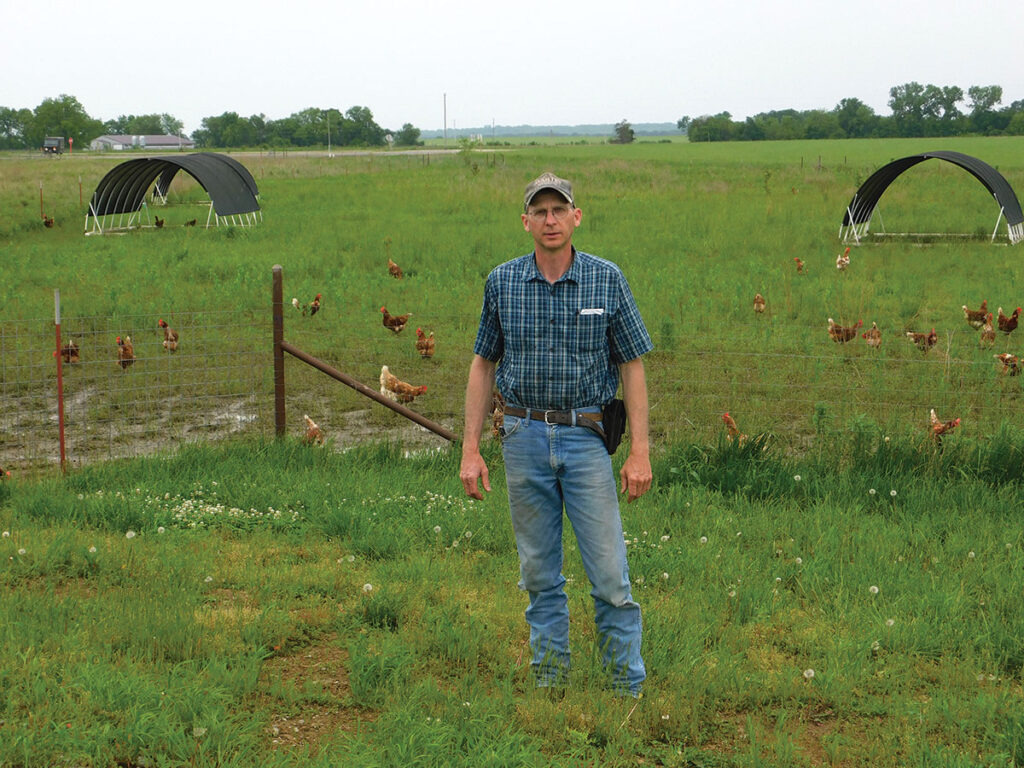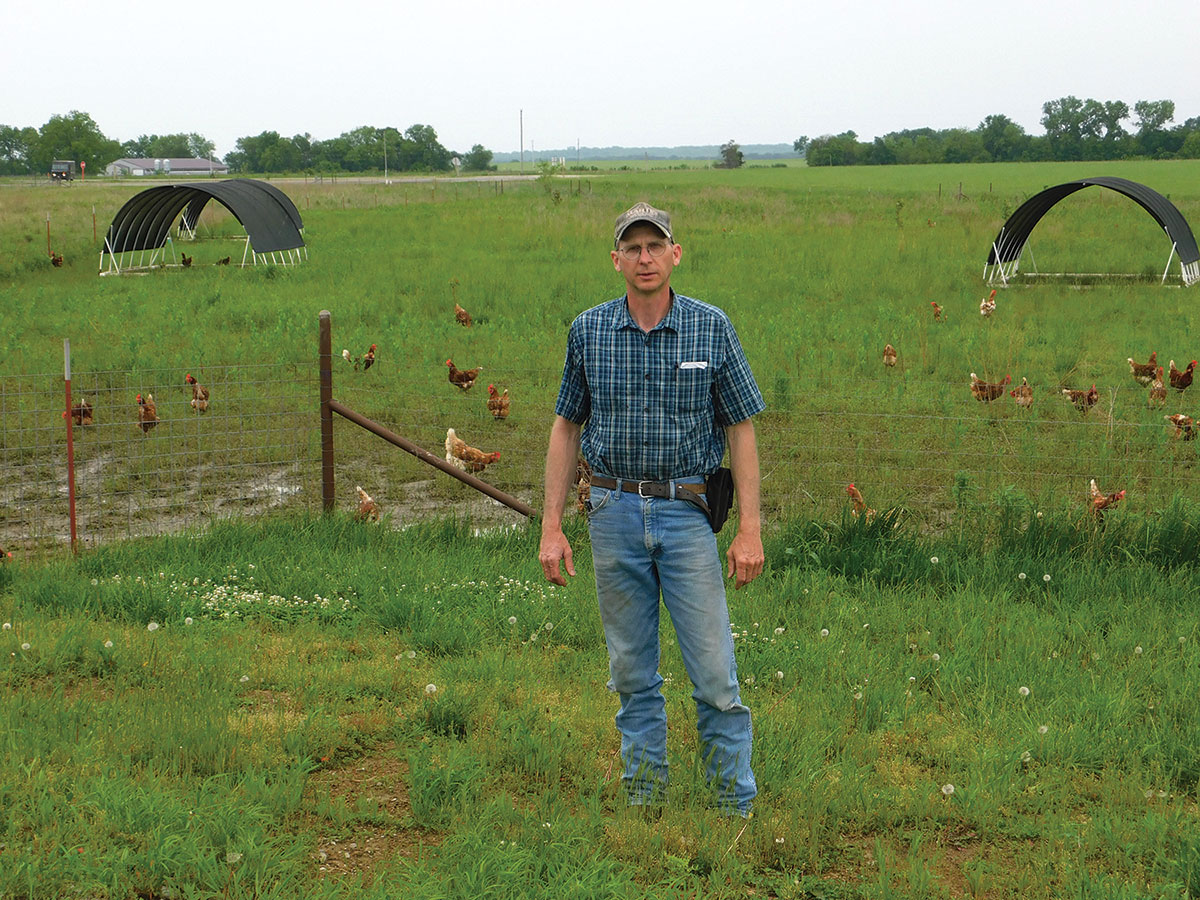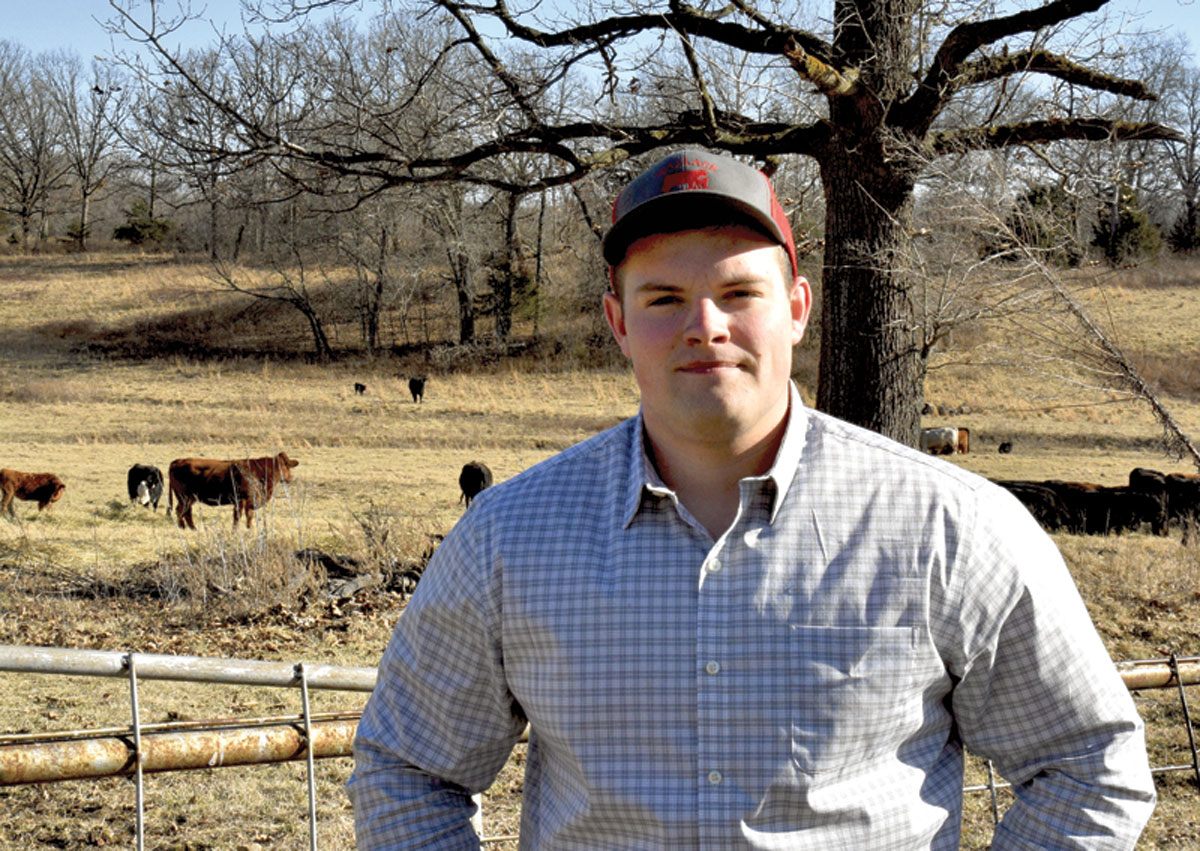
The incorporation of a laying operation has allowed Paul Schneider the opportunity to farm fulltime
WALKER, MO. – A happy hum almost musical in quality greeted Paul Schneider, of Walker, Mo., as he showed one of his chicken barns containing about 5,000 Hyline Brown hens. The reddish brown and white feathered chickens lay a brown egg.
Paul, his wife Krista, and sons Trenton (18) and Karsten (15) built their first chicken house in 2015. It is 50-feet-by-130-feet and houses about 4,100 chickens. They built the second house, which is 50-feet-by-150 feet, in 2016, and houses more than 5,000 hens.
“The thing I like most about raising laying hens is it is family oriented. Everybody does their part. My wife and I gather the first batch of eggs early in the morning. The boys gather later in the afternoon. In peak seasons, we gather three times a day,” Paul said. “Because of the chicken farm, I am able to stay on the farm with my family and make a living. This has long been a dream of mine.”
It may have been a dream, but sometimes in the beginning, it seemed more like a nightmare.
“It was a total learning experience,” Paul explained. “We got the first flock in late and they were older at 19 weeks. They trained us as we tried to train them. Each flock has been a bit different. It has to do with genetics, weather and how each barn reacts to the weather.”
They soon learned the lighting controlled the hens. They try to make it as natural as possible. Hens naturally head to roost when it starts getting dark. When they arrive as pullets, the chickens are unloaded on the floor. They then have to be nest trained and trained how to jump to the raised slats for feed and water. They have four rows of lights in each barn and use them to train the chickens. At night, the hens need to roost on the raised area where there are feed and water lines.
“The inner row of lights above the raised slats and nest dim automatically until they to encourage the chickens to roost in the dark where you want them to be,” Paul said. “The barns are fairly easy to operate It is very effective, but occasionally something goes wrong. The doors open and close automatically. The lights come on at 4:30 a.m. and go off at 9:30 at night. One night, I was in the field harvesting until well after dark. When I went to check them, about 50 hens were outside the barn doors, they had played around in the light by the doors and didn’t get inside the barn before the doors closed. It was after 2 a.m. before I got all the hens rounded up and put to roost. That was not one of my most enjoyable times being a chicken farmer.”
He couldn’t leave the chickens out all night because of the very real danger of predators. They have hawks, eagles, owls, and coyotes who will dig under the 4-foot fence. If left unchecked, coyotes can take a toll on the hens outside.
“A LOT OF THINGS HAVE TO HAPPEN TO PLANT ORGANIC OR RAISE ORGANIC EGGS. BUT IT IS WORTH THE EFFORT TO US.”
— PAUL SCHNEIDER
Both of the Schneider barns are cage free. They raise pasture-based hens who lay organic eggs and practice pasture rotation. To be labeled “pasture raised” certain qualifications have to be met. They have to have 2 1/2 and a half acres for each 1,000 birds. Paul has exceeded that amount and rotate the hens every 20 to 30 days. “The pasture recuperates.
“You always have fresh grass, which fresh grass, forage and insects adds to the yolk color,” Paul explained.
They have two flocks about eight weeks apart in age. Paul said chickens are different in how they relate to light, day length and weather, and even to noise.
They lost about 150 once when the big stir fans turned on the first time. It scared the chickens and they piled up and smothered. He worried if he’d been there 10 minutes earlier this might have been avoided, but realized you can’t win every time.
They currently have another flock of Lohman Brown hens. They experimented using the Bovan Brown and Lohman Brown breeds, but they have had far better production from the Hyline Brown. On peak days in the barn with about 4,280 to 4,265 hens, they got 4,200 eggs per day. They are with Vital Farms, which picks up eggs up every week. Eggs are taken to Springfield, Mo., where they are processed for distribution and sale.
The Schneiders feed a corn and soybean mix with calcium and minerals in an automatic feeder which runs four times a day. They feed an average of about 25 to 27 pounds of feed a day per 100 hens.
The barns are heated to about 50 to 55 degrees in the winter, with a lot of ventilation fans. In the spring, not much cool air is needed, but foggers are used in the summer to help control the heat. There are five sun shades with water piped into automatic waterers in each site pen where the chickens spend a lot of time in the pastures.
Hens don’t have many health problems, but Paul keep watch on the eggs. A colored or misshaped egg can be a sign of bronchitis. That problem could be from over or under ventilation, wet, damp, hot or cold weather. Paul uses probiotics in the water line, including apple cider vinegar and salt. “Microbes improve gut health. In organic production lines, this is very important. A healthy hen just lays more eggs.”
They get the pullets when they are 16 to 17 weeks old and keep them for approximately 78 weeks, getting a little over a full year of production. When they disperse, they sell to individuals.
“People really want the hens and I feel good about the hens coming to a good end of life on my farm.”
When the barns are cleaned, they raise the feed and water lines to the ceiling, remove the raised slats, take the litter out with a skid steer, sweep, and power wash with hot pressure washer, water. “I found the hot water cleans most effectively.”
The barn dries for a day or two while they repair any equipment that might be faulty before putting it back. They disinfect with a fogger before a new flock comes in. The day before, pine shavings are put on the floor. “The barn is clean and disinfected and we are ready to go again.”
The Schneiders also raise organic row crops, mainly milo, soybeans, wheat and sometimes corn.
“A lot of things have to happen to plant organic or raise organic eggs,” Paul said. “But it is worth the effort to us.”







